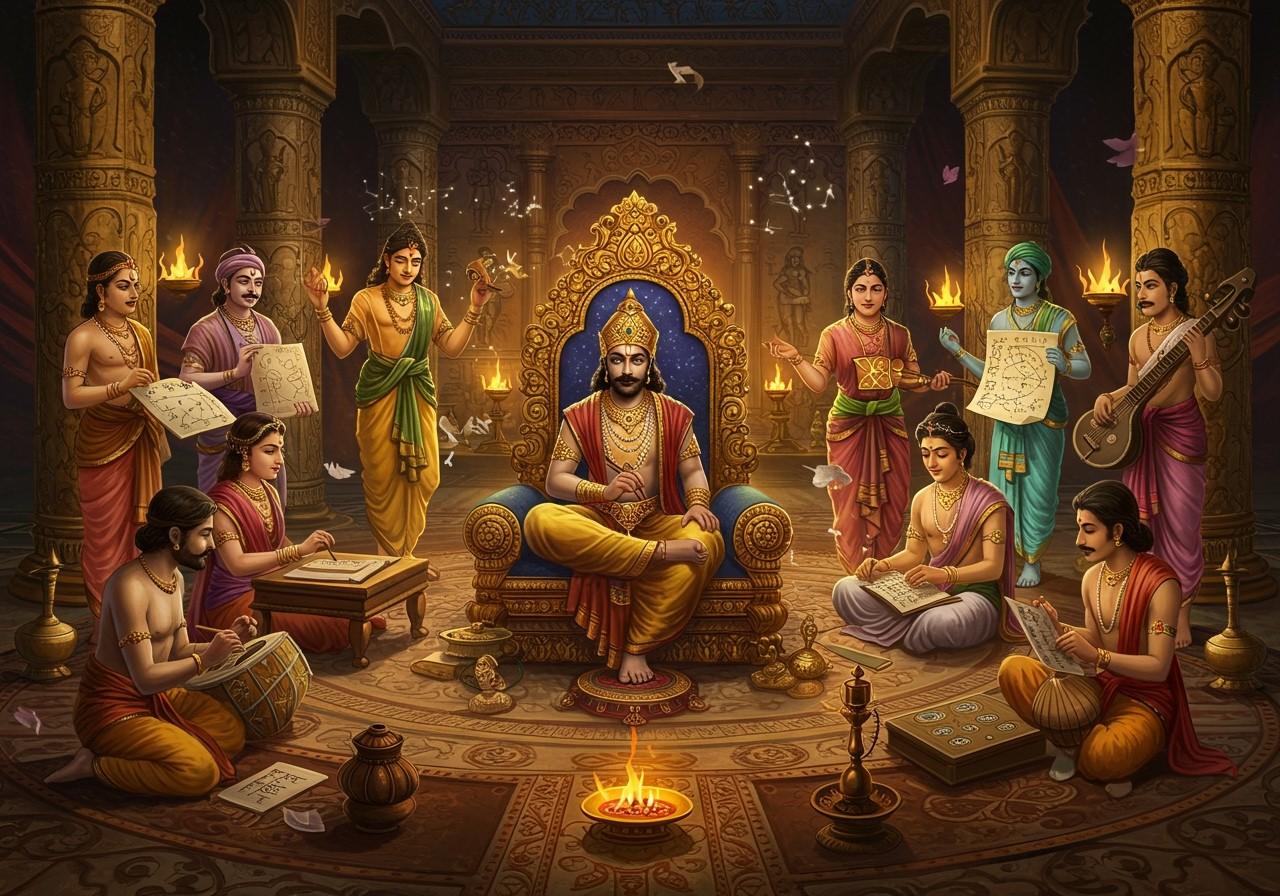
The Gupta Empire, flourishing from the mid-3rd to the mid-6th century CE, is often hailed as India’s Golden Age. This era witnessed remarkable advancements in literature, science, and the arts. Among the most prominent rulers was Chandragupta II, also known as Vikramaditya. His court boasted nine exceptional scholars and artists, known as the Navratnas, or Nine Gems. This blog delves into the lives and contributions of these influential figures who shaped the cultural and intellectual landscape of the Gupta period.
Historical Context
To appreciate the contributions of Chandragupta II’s Nine Gems, understanding the historical backdrop of the Gupta Empire is crucial. The Guptas unified a significant portion of India, ushering in an era of peace and prosperity, from the mid-3rd to the mid-6th century CE. This stability fostered cultural and intellectual growth. Chandragupta II’s reign (around 380-415 CE) marked a period of significant artistic and scholarly achievements, actively supported by the king himself.
Kalidasa: The Poet and Dramatist
Kalidasa is widely regarded as the greatest Sanskrit poet and dramatist. His renowned works include plays like Shakuntala and poems such as Meghaduta and Raghuvamsha. Celebrated for their lyrical beauty and profound themes, Kalidasa’s compositions continue to be studied and cherished today. His works provide a window into the refined literary sensibilities of the Gupta era.
Amarasimha: The Lexicographer
Amarasimha is best known for his masterpiece, the Amarakosha, an ancient thesaurus of Sanskrit words. This lexicon remains an invaluable resource for scholars and students of Sanskrit, offering insights into the richness and nuances of the language during the Gupta period. Amarasimha’s meticulous compilation highlights the linguistic richness of his time and his commitment to preserving the language for future generations.
Varahamihira: The Astronomer
Varahamihira was a distinguished astronomer, astrologer, and mathematician. His seminal work, Brihat Samhita, encompasses a range of subjects, from astronomy and astrology to architecture and horticulture. His contributions significantly advanced the understanding of celestial phenomena and their influence on human affairs. His insights into astrology and astronomy reflect the scientific curiosity of the Gupta era.
Dhanvantari: The Father of Ayurveda
Dhanvantari is revered as the father of Ayurveda, the traditional Indian system of medicine. His work in developing Ayurvedic texts and practices has had a profound and enduring impact on health and wellness in India. Dhanvantari’s emphasis on holistic and preventive healthcare continues to influence modern medical practices. His contributions reflect the Gupta Empire’s focus on health and well-being.
Kshirasvamin: The Grammarian
Kshirasvamin, a respected scholar of grammar and linguistics, played a vital role in refining and preserving the Sanskrit language. His commentaries on ancient texts and his efforts to standardize Sanskrit grammar were essential in maintaining the language’s purity and precision. His work reflects the Gupta period’s emphasis on scholarship and the preservation of knowledge.
Shanku: The Architect
Shanku, a prominent architect of the Gupta era, established fundamental principles of design and construction. His guidelines for building temples, palaces, and other structures showcase the architectural advancements of the period. His work reflects the Gupta Empire’s focus on aesthetics and functionality in architecture.
Ghatakarpara: The Poet
Ghatakarpara, though less renowned than Kalidasa, was another esteemed poet of this golden age. His elegant verses contributed to the rich tapestry of Gupta-era poetry, showcasing the depth and breadth of literary talent during Chandragupta II’s reign. His works are admired for their emotional resonance and literary craftsmanship.
Shapanaka: The Astrologer
Shapanaka, a revered astrologer in Chandragupta II’s court, played a significant role in advising the king on important matters. His knowledge of celestial bodies was highly valued and influenced decision-making in various aspects of life during that period. His influence reflects the importance of astrology in Gupta society.
Vetalbhatt: The Scholar
Vetalbhatt, a celebrated poet and scholar, enriched the cultural landscape of Chandragupta II’s reign. His writings often explored themes of morality, philosophy, and ethics, contributing to the intellectual discourse of the time. His work reflects the Gupta era’s focus on philosophical inquiry and moral reasoning.
How Poojn.in Helps Preserve the Legacy of the Nine Gems
Poojn.in offers authentic ritual items that connect you to the rich cultural heritage of the Nine Gems (Navaratnas) of Chandragupta II’s court. Our collection includes traditional items that honor this important historical period (mid-3rd to mid-6th century CE):
-
Chandika Haar and Traditional Necklaces: We offer a wide selection of traditional necklaces reminiscent of those worn during the Gupta period, available in various regional styles, including Gujarati Chandika Haar and North Indian Chandni Haar designs. These pieces serve as beautiful tributes to the rich artistry of the Gupta era. You can find a wide variety of traditional necklaces and other jewelry at poojn.in.
-
Ritual Items for Scholars: To honor the scholarly traditions of figures like Kalidasa, we provide complete puja sets, brass items, and educational materials related to ancient Sanskrit texts. These items allow you to connect with the intellectual pursuits of the Gupta period. Explore our collection of puja items and other religious artifacts at poojn.in.
Conclusion
Chandragupta II’s Nine Gems were more than just scholars and artists; they were visionaries who shaped the intellectual and cultural landscape of the Gupta Empire. Their enduring contributions to literature, science, medicine, architecture, and astrology continue to be celebrated today. By fostering these exceptional talents, Chandragupta II secured a legacy of knowledge and artistry that inspires generations. The Gupta period endures as a golden chapter in Indian history, distinguished by remarkable achievements and timeless works that reflect the brilliance of its Nine Gems.


